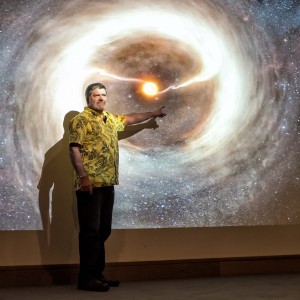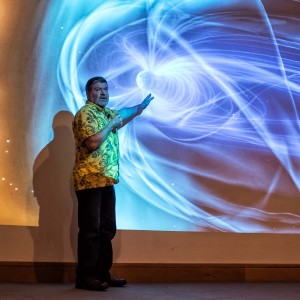December 9, 2013
Building the Solar System
Greg Smye-Rumsby
Report by: Chris Sutcliffe
Greg Smye-Rumsby is a popular planetarium presenter at the Royal Observatory, where he also leads astronomy classes. He produces detailed star maps and astronomical artworks for ‘Astronomy Now’ magazine, and is well known to members of the Flamsteed, having given some very popular lectures to us in the past.
Greg stated that, had he given this lecture 5 years ago, he would have been pretty confident that we knew most things about how the Solar System was formed. However, nowadays, we seem a little more confused!
So what does the Solar System consist of? One star (the Sun!), 8 planets, 180 moons, 4 plutoids, millions of asteroids and trillions of comets. Most of the mass of the Solar System resides in the Sun, and most of the Solar System is mainly empty space. The Sun is a pretty average G-class star.
What do we mean by ‘building the Solar System’? Greg explained that ash from cigarettes has a similar consistency to the dust grains left behind from supernovae. The dust sticks together and tends not to want to come apart. Matter starts to clump together. In the centre of the matter, we have the greatest amount of mass and the highest density. As we move outwards, the density falls off, so it is less likely that planets will form far away from a star.
When we look at images of the Orion Nebula, we can see clumping of matter around stars that are forming, with protoplanetary disks of matter surrounding them.
When the Solar System was first formed, there were lots more planets and comets. It seems likely that the planet Jupiter spiralled in from the outer reaches of the Solar System, causing huge disruption to planetary orbits. It is possible that Uranus and Neptune changed places as a result. As the planets were disrupted, comets and meteors flew everywhere. This caused the late heavy bombardment, which we can see evidence of today in the craters on the Moon.
The Dawn spacecraft has already investigated the asteroid Vesta and is moving on to Ceres in 2015. Vesta is interesting because it might be one of the proto-planets or planetesimals left untouched by the chaos in the early Solar System. By studying Vesta we will learn more about the Solar System.
Greg went on to describe the objects within the Solar System.
EARTH: Most of the surface of the Earth is liquid. Liquid water is exceptionally rare. The core is about the size of Mars, and consists mostly of iron and nickel. The crust is only 15km thick. It has an internal magnetic field that is pretty much in line with the axis of rotation. However, the magnetic field is drifting and the magnetic field reverses from time to time. Most of our water probably came from comets and asteroids. The Moon was almost certainly formed by a collision with a Mars-sized body, though analysis of the chemical compositions of the Earth and Moon may require this theory to be amended. After formation, the Moon was 10-times closer to the Earth than it is today, causing massive tidal forces.
MARS: With a diameter of around 6,800km, it is around half the diameter of Earth. It is the planet most like the Earth in that it has season and an atmosphere with clouds, winds and dust storms. That said, it is still very different to the Earth. The Mars probes, in particular Opportunity and Curiosity, have shown that liquid water must have existed on Mars at some time in the past. Because Mars doesn’t have a magnetic field, the solar wind is able to rip apart molecules into single atoms and ionises them. Over millions of years, Mars slowly lost much of its atmosphere.
Water is frozen permanently and overlaid with dust. The Mars rover Spirit had a failure in one of its wheels, which meant that the wheel was being dragged across the surface. This revealed a white substance under the surface. This turned out to be gypsum, which can only be made in the presence of water. Today, Mars has a limited amount of very salty water, which occasionally is heated up, becoming liquid on the surface. This water doesn’t last very long before being sublimated. Curiosity has found evidence of sweet water in the distant past of Mars, but it is not present today.
Mars shows no signs of life either today, or, so far, evidence of any life in the past.
VENUS: The atmosphere consists mostly of carbon dioxide. Sulphuric acid is also present. The planet does have a magnetic field, but it is not very powerful. The temperature of the surface is around 462 degrees Celsius. Though the wind on Venus only moves at around 1 metre per second, the dense atmosphere would mean that this wind would easily push you over. There are massive shield volcanoes everywhere.
MERCURY: Mercury has an iron core. The surface of Mercury seems to have a lot more colour than our Moon. There is some volcanic activity on Mercury.
JUPITER: Jupiter has 2.5 times the mass of all the other planets in the Solar System. Its diameter is 11.2 times that of Earth and it rotates in only 10 hours, the quickest of all the planets. It has a massive magnetic field that would stop the human body functioning if we went too close. It has 67 confirmed moons, with Ganymede being the biggest moon in the Solar System; Ganymede has a magnetic field and an atmosphere. Io has a huge amount of volcanic activity caused by tidal heating resulting from its close orbit to Jupiter.
SATURN: The Cassini spacecraft is currently going over the top of Saturn and obtaining amazing images of its ring system. The ring system is permanent and white in colour. Ice crystals are gravitationally held in the plane of the ring. The moon Enceladus seems to have liquid water under the surface, with occasional cryo-volcanoes shooting large jets of water into space. This water ice contributes to the ring system. Titan, the largest moon of Saturn, has a thick atmosphere of nitrogen and methane. There are oceans on the surface, which are made of liquid methane.
URANUS: Uranus seems to be quite featureless, with an atmosphere of hydrogen, helium and methane. It has an extraordinary axial tilt, meaning that its axis of rotation is almost parallel to the plane of the Solar System. Uranus radiates hardly any excess heat into space, which is not fully understood. Neptune, for example, radiates around 2.6 times as much energy into space as it receives from the Sun.
NEPTUNE: The farthest planet from the Sun. Its largest moon, Triton, has a retrograde orbit and is geologically active.
With his renowned outgoing personality and humour, Greg gave us an fascinating insight into the Solar System.
Pictures from the Evening (by Mike Meynell):
Posted under: Flamsteed, Flamsteed Lecture, Meeting Report











You must be logged in to post a comment.